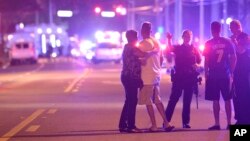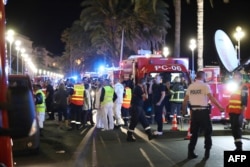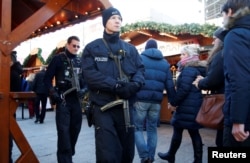The Islamic State militant group is increasing online efforts to encourage sympathizers in the West to mount attacks in their home countries. The incitements include online posts detailing ways to manufacture crude chemical weapons.
The group's propagandists are not disguising the main aim of their leaders: to force Western powers to focus on their own security needs at the expense of pursuing the fight against IS in the terror group's self-declared caliphate, which has shrunk enormously in recent months.
Followers are being urged to mount attacks that will exhaust the economies of their enemies in online propaganda monitored by the Middle East Media Research Institute, a Washington-based organization.
In the latest issue of IS's weekly online magazine, al-Naba, posted January 5, an article titled "A Monotheist Is an Army on His Own" celebrates attacks already mounted in the "land of unbelief." Among the attacks highlighted are last June's shooting at a gay nightclub in Orlando, Florida, that left 49 dead and 53 wounded; the Bastille Day attack in Nice, France; and the Berlin Christmas market assault by a Tunisian who deliberately plowed a stolen truck into shoppers and revelers.
The terror so far inflicted has "drained" the enemies' resources needed to strengthen homeland security, "exhausted" Western soldiers and police officers, and "humiliated" their governments, which "failed" to defend their countries, the magazine says.
Links on Telegram
Links to download al-Naba were posted on a pro-IS channel on Telegram, the Germany-based encrypted messaging app, which has become a preferred communications platform for jihadists.
"These and the other attacks," al-Naba noted, "are sufficient to prove the extent of vexation that one mujahid, who is honest with Allah and has a sincere jihadi intention, could inflict if he properly prepares with the available resources at his disposal and goes forth to execute his attack while asking Allah to grant him success."
Last week, the Telegram channel of Lone Mujahid, which periodically provides suggestions on attack methods, posted several threats to the United States along with instructions on building pressure cooker bombs similar to those used by the 2013 Boston Marathon bombers, who killed three and injured nearly 250 others.
On January 3, the channel published a poster that included instructions on manufacturing a chemical weapon. The channel noted that the dissemination of "disease[-inducing] and chemical gases completely paralyzes life in vital [enemy] areas."
Listing ingredients and providing assembly instructions for one such device, the post added that, if properly followed, "the interaction [of chemicals] will start and the countdown of [the] demise of America will as well, inshallah [God willing]."
Lone Mujahid promised to provide further explanations on the "use of corrosive chemicals, poisons and explosive materials."
Propaganda surge
The increase in online efforts to encourage sympathizers in the West to mount attacks in their home countries is part of an IS propaganda surge that has included the kind of big production videos the terror group was regularly posting when it was at the peak of its power in 2014.
For most of last year, IS's overall media output had decreased noticeably, most likely as the result of the military pressure the terror group has come under across its self-declared caliphate in both Iraq and Syria, say analysts.
The production surge and increase in online efforts may partly be due to the two-week lull in fighting in Mosul, where Iraqi forces took time to recalibrate their battle order for a renewed push to retake the city from IS.
Not to be outdone, IS's jihadist rivals in al-Qaida have also increased calls for attacks in Western countries. A pro-al-Qaida Telegram channel has distributed short videos inciting Muslims to conduct attacks in the West and in Russia.
As the conflict in Syria has dragged on, jihadist fighters and propagandists in Syria and Iraq, as well as their supporters in the West, have utilized several social media platforms, said Anat Agron, a MEMRI researcher.
Aside from Telegram, Snapchat appears to be popular with fighters in al-Qaida-linked Jabhat Fateh al-Sham, or JFS, formerly known as the al-Nusra Front.
Snapchat is an image messaging and multimedia mobile application created by former Stanford University students. It differs from other social media apps in that it allows users to share short-lived images that self-delete. Users can set how long their content will be visible within a 24-hour limit, after which all traces of what has been uploaded are wiped from the app. The California-based Snapchat's parent company is likely to go public this year.
Wartime experiences
In a MEMRI report due out this week, Agron notes that fighters in Syria share photos and videos on Snapchat to illustrate their lives in the war zone. They use it to show off their weapons, to highlight damage caused by coalition airstrikes and to fundraise. An Australian JFS fighter named Ahmed Shaheed posted a photo in June of an AK-47 he had obtained, which he claimed had been used by al-Qaida founder Osama bin Laden.
"Had to buy a gun that sheikh Osama use [sic] to have," his Snapchat post read.
Of jihadist users, JFS members appear to have more Snapchat accounts than their IS rivals, most likely because of the more restrictive media policies the terror group imposes on its fighters. IS warned members recently that authorities might be able to track users.
Family members of three Americans killed in IS attacks in Belgium and France sued Twitter on Monday for allegedly failing to keep members of the terror group off its platform.










